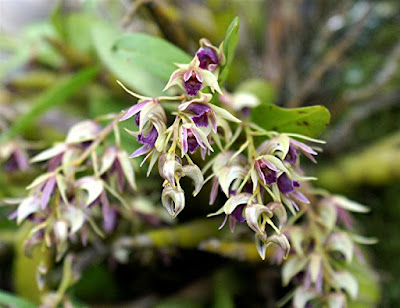Dendrobium strongylanthum is native to North-west Thailand near Chiang Mai, northern Myanmar (Burma) near the southern China Hills and the western and south-western part of the Yunnan Province in China, where the height of the natural habitat is 1000-2000 m...
Dendrobium strongylanthum also called as The Bulging Flower Dendrobium, Callista strongylantha, Dendrobium ctenoglossum, is a species of the genus Dendrobium. This species was described by Heinrich Gustav Reichenbach in 1878.
IDENTIFY DENDROBIUM STRONGYLANTHUM
Dendrobium strongylanthum is native to North-west Thailand near Chiang Mai, northern Myanmar (Burma) near the southern China Hills and the western and south-western part of the Yunnan Province in China, where the height of the natural habitat is 1000-2000 m.
It is a mini-miniature sized, cool to cold growing epiphyte, which reaching 15 cm in height, with a few, slender, 10 cm long, pendulous, vertically ribbed, slightly fractiflex canes enveloped near the nodes by sheaths and carrying 5, oblong to lanceolate, obtuse, slightly unequally bilobed apically, 3-5 cm long leaves.
The Bulging Flower Dendrobium blooms in the late spring through early fall on often more than one, 10 cm long, 6 to 8 flowered inflorescence arising from the nodes near the apex of the cane and carrying all the flowers towards the apex clustered in a loose ball. The flowers are 1-2 cm in diameter. The petals of both whorls are narrow and straight. The outer coat flakes are dark purple on the back and the front and are stained dark purple-brown at the base. The inner whorls are greenish-yellow with purple spots. The lip, bent at the top, is covered with warts and deeply curled along the brown edges. It is serrated up to half. The lowered bulge has a bulge in the middle and a wart at the front.
DENDROBIUM STRONGYLANTHUM CARE AND CULTURE
Cultural information should only be used as a guide, and should be to be adapted to suit you. Your physical location; where you grow your plants, how much time you have to devote to their care, and many other factors, will need to be taken into account. Only then can you decide on the cultural methods that best suit you and your plants.
Light:
Dendrobium strongylanthum needs a light level of 15000-24000 lux. Distributed light is recommended and you should avoid exposing plants to direct sunlight.
Temperature:
The average temperature of the day in summer is 25-27 ° C, night 18-19 ° C, giving a daily difference of 7-9 ° C. In spring, the average day temperature is 29-30 ° C, 16-18 ° C night, giving a daily difference of 11-14 ° C. The average temperature of the winter day is 24-27 ° C, the night 8-9 ° C, and the daily difference is 15-18 ° C.
Humidity:
During the summer, The Bulging Flower Dendrobium needs the average humidity of 80-85%, but drops to 65-75% in the rest of the year. However, at the end of the dry season in late winter and early spring, it drops to 60% for a period of about 2 months.
Substrate, growing media and repotting:
Dendrobium strongylanthum can be grown mounted on tree-fern rootstocks or cork as long as we can provide high humidity and watering in summer at least once a day. If they are grown in pots, any loose, fast-drying substrate is recommended. Repotting is best done at the beginning of spring, when new roots begin to grow.
Watering:
During the growing season, from spring to early autumn, the precipitation is abundant. During this period, the plants should be constantly moist with little, if any, drying between waterings. When new growths reach maturity in autumn, the amount of water should be gradually reduced.
Fertilizer:
It is recommended to apply a 1/4-1/2 dose of orchid fertilizer weekly. It is preferable to use high-nitrogen fertilizer from spring to mid-summer, and then use high-phosphoric fertilizer until the end of autumn. You can also get good results in alternating fish emulsions and normal fertilizers.
Rest period:
Dendrobium strongylanthum are able to tolerate for a short period of decline even below 0 ° C, but in cultivation they should avoid such extreme conditions. In the cold weather, the plants will survive the least damage if they are dry. In winter, the plants should dry out between waterings, but they can not stay dry for too long. Fertilization should be significantly reduced or eliminated whenever the amount of water is reduced.















COMMENTS